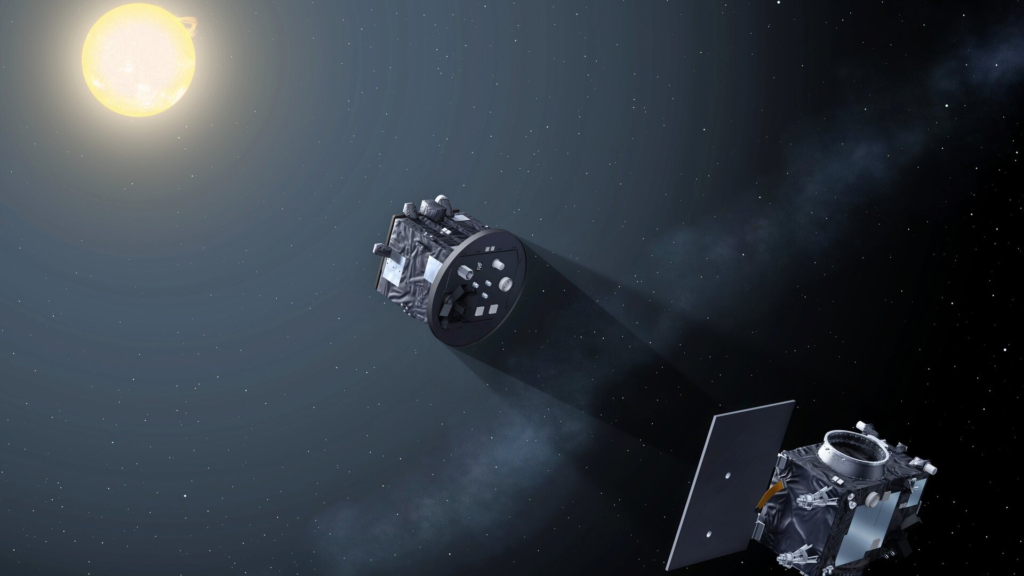The Proba-3 mission, set to launch on December 4, marks a groundbreaking collaboration between the European Space Agency (ESA) and the Indian Space Research Organisation (ISRO).
This mission aims to revolutionize our understanding of the Sun’s corona by creating an artificial solar eclipse in space. Using two satellites—an Occulter Satellite (OSC) and a Coronagraph Satellite (CSC)—Proba-3 will offer continuous, high-precision observations of the Sun’s outer atmosphere, paving the way for new insights into solar dynamics and space weather prediction.
Science Behind the Proba-3 Mission
The core innovation of the Proba-3 mission lies in its ability to simulate a solar eclipse using advanced formation-flying techniques. Traditional solar eclipses, where the Moon blocks the Sun’s light, provide a rare and fleeting opportunity to observe the solar corona, the Sun’s outermost layer.
This corona, although faint, holds critical information about solar activity, including the origins of solar storms and coronal mass ejections (CMEs).
Proba-3’s artificial eclipse mechanism is designed to overcome the limitations of natural eclipses and traditional coronagraphs. The mission comprises two main components: the Occulter Satellite (OSC) and the Coronagraph Satellite (CSC).
The OSC carries a 1.4-meter occulting disc, which will block sunlight and cast a precise shadow. Positioned approximately 150 meters away within this shadow, the CSC contains a specialized telescope with a 5-centimeter aperture.
This setup will allow the telescope to capture detailed images of the corona without being overwhelmed by the Sun’s intense brightness, which is about a million times stronger than the corona’s brightest point.
Read : Europe’s Proba-3 Satellites to Soon Be Mated with India’s PSLV Rocket
One of the most challenging aspects of the mission is maintaining precise alignment between the two satellites. They must fly in formation with millimetric accuracy to ensure that the CSC remains perfectly positioned within the shadow created by the OSC.
📽️Follow the double-satellite Proba-3's mission to view the Sun's corona by making artificial eclipses in orbit – an @ESA mission being launched by @ISRO from India https://t.co/vG3mzpdY32 pic.twitter.com/yPmKn7g7IB
— ESA Technology (@ESA_Tech) November 19, 2024
This intricate maneuver will be performed at the apogee of their elliptical orbit, roughly 60,000 kilometers from Earth. At this distance, gravitational forces are weaker, which helps minimize the propellant needed for station-keeping and enables long-duration observations.
Importance of Studying the Solar Corona
The solar corona is a critical area of study for understanding the Sun’s behavior and its impact on the solar system. This outer layer of the Sun extends millions of kilometers into space and is the source of phenomena such as solar flares and CMEs.
These events can have significant repercussions on Earth, affecting power grids, satellite communications, and even GPS navigation systems.
Observing the corona is notoriously difficult due to its faintness compared to the Sun’s main disc. Traditional ground-based telescopes and even space-based observatories face challenges because of light diffraction and the overwhelming brightness of the Sun.
While coronagraphs, which use occulting discs to block sunlight, have been in use since the 1930s, they have inherent limitations. The bending of light around the edges of the occulting disc creates a halo effect, making it difficult to observe the inner regions of the corona with clarity.

Natural solar eclipses provide an ideal but rare opportunity to study the corona in detail. However, these events last only a few minutes and occur infrequently. Proba-3’s artificial eclipse will address these challenges by offering continuous observation periods lasting up to six hours during each 20-hour orbit.
This extended observation time, combined with the precision of space-based instruments, will allow scientists to study dynamic processes within the corona in unprecedented detail.
The mission will focus on the “gap region” between the low and high corona, an area that has remained largely unexplored due to the limitations of previous observation techniques. Understanding this region is crucial for unraveling the mechanisms behind solar wind acceleration and the formation of CMEs.
Insights gained from Proba-3 could significantly enhance our ability to predict space weather events, which are becoming increasingly important as our reliance on technology grows.
Technological Innovations and Future Implications
Proba-3 represents a significant leap forward not only in solar research but also in space technology. The mission will test and validate several advanced spaceflight techniques, including acquisition, rendezvous, and formation flying. These capabilities are essential for future space missions involving multiple satellites or spacecraft working in tandem.
One of the key challenges of the mission is maintaining the precise alignment between the OSC and CSC. The satellites will use a combination of GPS, star trackers, and laser-based sensors to achieve and maintain this alignment. The mission’s elliptical orbit, which takes the satellites to a distance of 60,000 kilometers from Earth, is another critical factor.
At this distance, the weaker gravitational forces reduce the amount of propellant needed for station-keeping, allowing the satellites to drift passively for much of their orbit. This approach minimizes fuel consumption and extends the mission’s operational lifespan.

The data collected by Proba-3 will have far-reaching implications for both scientific research and practical applications. By providing a more detailed and continuous view of the solar corona, the mission will enhance our understanding of solar dynamics and improve space weather forecasting models.
This, in turn, could help mitigate the impact of solar storms on Earth, protecting critical infrastructure and ensuring the reliability of communication systems.
Moreover, the technological advancements demonstrated by Proba-3 will set the stage for future missions that require precise formation flying. These techniques could be applied to a wide range of scientific and commercial applications, from deep-space exploration to Earth observation.
The Proba-3 mission is poised to make significant contributions to our understanding of the Sun and its impact on the solar system. By creating an artificial solar eclipse in space, it will provide unprecedented insights into the solar corona, helping scientists unravel the mysteries of solar activity and improve our ability to predict space weather.
The mission also represents a major technological milestone, showcasing advanced spaceflight capabilities that will pave the way for future exploration.

